Golden Grove sits in the Parish of Llangathen, and is set in a picturesque agricultural area in the Towy Valley, north of Carmarthen. The Parish is served by the Church of Llanfihangel Aberbythych, inside of which is an Altar Cross, which was donated to the Church as a war memorial for its four former Parishioners who fell during the Great War.
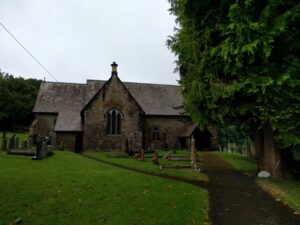
The Great War, 1914-1918
The Honorable Eric Octavius Campbell, DSO & Bar, Lieutenant-Colonel, Seaforth Highlanders. Eric was born on 3 December 1885, the youngest son of Frederick Archibald Vaughan Campbell, 3rd Earl Cawdor and Edith Georgina Campbell, Countess Cawdor, of Golden Grove, Stackpole Elidor and Cawdor Castle, Nairnshire. He was born in 1885, and after going to Eton passed into the Army through the Militia, being gazetted to the Seaforth Highlanders on 20 December 1905. At the outbreak of the war be went to France as adjutant of the second battalion, was awarded the DSO on 18 February 1915, and was wounded at St. Julien on 25 April 1915. He was employed as brigade major from 3 January 1915 to 24 September 1916, his services being rewarded with a brevet majority on 3 June 1916. He was in hospital In France towards the end of 1918, and on return to duty in November went to the second battalion, but resumed the appointment of brigade major to 44 Infantry Brigade on 22 January 1917. Eric returned to regimental duty on 27 May 1917, and for a short time commanded the Second battalion. On 20 October 1917, he was given command of another battalion of the Seaforth Highlanders, which he retained till the middle of May, 1918, when a breakdown in health, due to nearly four years active service, compelled him to go to hospital. He arrived home on 25 May, having been repeated wounded, but returned to duty immediately, as he was only bruised by a fragment of a shell. In the Gazette of 24 May 1918 he was mentioned in dispatches for the third time, and a bar to his DSO was awarded in the Gazette of 3 June 1918. Sadly Eric died of cerebral haemorrhage on 4 June 1918 in Hospital in London. He was 33 years old, and was buried in the Cawdor Plot of Stackpole Elidor Churchyard, Pembrokeshire.
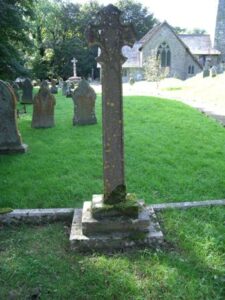
Alcwyn Christmas Evans, Private, 320495, Welsh Regiment. Alcwyn was the son of David and Harriet Evans, of Caefadog, Llanarthney. He had enlisted at Carmarthen into the Army, joining the 24th Battalion, Welsh Regiment. The battalion had been formed in Egypt early in 1917 by the merger of the Pembroke and Glamorgan Yeomanry Battalions, and became part of 231 Brigade, 74th (Yeomanry) Division. Sadly Alcwyn was not long with his new battalion. He took ill with enteric fever, and died as a result on 12 May 1917. He was 23 years old, and is buried at Kantara War Memorial Cemetery, Egypt. His brother Evan died just three months later.

Evan Evans, Lance Corporal, 25833, Lancashire Fusiliers. Evan was the elder son of David and Harriet Evans, of Caefadog, Llanarthney. He originally enlisted at Llanelli into the Royal Field Artillery, but was later transferred to the 11th Battalion, Lancashire Fusiliers, part of 74 Brigade, 25th Division. The Division landed in France on 26 September, 1915, and were posted to the Vimy area, where they defended Vimy Ridge against a German attack in May 1916. They then moved to the Warloy area and attacked on 3 July near Thiepval. They fought throughout the Battle of the Somme, and then moved to Ploegsteert, where they held the line for the months leading up the Battle of Messines in June, 1917. Evan was killed just before the division moved to Ypres from Messines, on 10 August 1917. He was 28 years old, and is commemorated on the Ypres (Menin Gate) Memorial, Belgium. Evan’s death was a tremendous blow to his family, as his brother Alcwyn had died just three months previously.
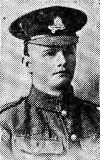
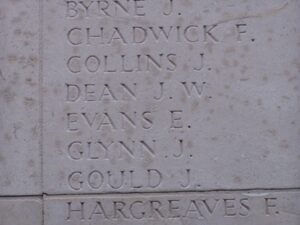
Richard Henry Grover, Driver, 136006, Royal Field Artillery. Richard was born at Bethnel Green in 1894, the son of Richard and Elizabeth Grover. By 1911 he had moved to Golden Grove, and worked as a farm labourer for James and Maria Roberts. He married Margaret Evans in 1916, before enlisting at Ammanford into the Royal Field Artillery. Richard was posted to the 87th Battery, 2nd Brigade, part of 2nd Division. The division had been in France since the start of the war, and had fought at during the withdrawal to the Marne, and at First Ypres and Loos. In 1916 they had taken part in the Somme battles, before moving to Arras where they saw further action in 1917. Later that year they took part in the Battle of Cambrai, and it was here that Richard was killed on 23 September 1917. He was 24 years old, and is commemorated on the Cambrai Memorial, Louverval, France. His widow remarried after the war, and moved to Fron Deg, Waterloo Road, Penygroes. Richard is not commemorated on the Golden Grove Memorial.
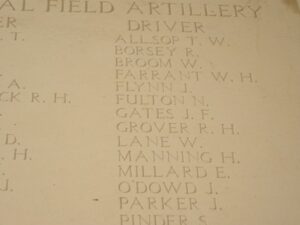
John Jones, Sergeant, 686, Princess Patricia’s Canadian Light Infantry. John was born at Golden Grove on 23 March 1890, the son of Benjamin and Ann Jones, later of Llandebie. He served prior to the war in the Middlesex Regiment, but then emigrated to Canada, where he was one of the first to enlist, on 20 August 1914, into the Princess Patricia’s Canadian Light Infantry. The PPCLI sailed from Quebec on 27 September 1914, and after a few days in England moved to France on 21 October. They moved to trenches near Ypres, at Dickebusch, attached to the 27th Division, and fought at St. Eloi and Second Ypres, and in December, 1915 they joined the newly formed 7th Canadian Brigade, 3rd Canadian Division. They fought with the Division at Mount Sorrel in June 1916 before moving to the Somme, where they fought at Flers, Thiepval and Le Transloy, where John was wounded. He was brought back to the Base Hospital at Wimereux, where he Died of Wounds on 13 October 1916, aged 23. He is buried in Wimereux Communal Cemetery, France. John is not commemorated on the Golden Grove Memorial.
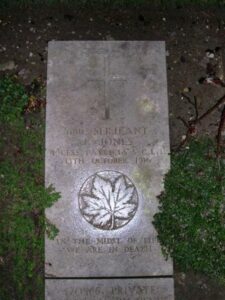
Ronald Grove Jones, Private, 8524, Leicestershire Regiment. Ronald was born at Golden Grove in 1890, the son of John and Sarah Jones. The family moved to 109, Lark Hall Lane, Clapham at the turn of the century and Ronald enlisted there into the Middlesex Regiment on 28 March 1908, but then transferred to the 2nd Battalion, Leicestershire Regiment. He was stationed with the battalion in India at the outbreak of war, where it was attached to the Garwhal Brigade, 7th (Meerut) Division, and the division was recalled to France to reinforce the stretched BEF. The division took up positions in Northern France, where they saw heavy action the following year, during the Battle of Festubert. Ronald was killed here on 15 May 1915, aged 25. He has no known grave, and is commemorated on the Le Touret Memorial, Richebourg L’Avoue, France. Ronald is not commemorated on the Golden Grove War Memorial.
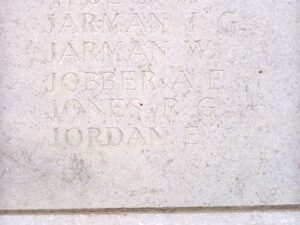
Thomas Rees, Private, 44253, South Wales Borderers. Thomas was born at Golden Grove around 1886, the son of John and Elizabeth Rees. The family later moved to the Three Compasses, Llangathen. Thomas resided at 6, Cromwell Street, Swansea prior to the war, and enlisted at Chatham into the 2nd Battalion, South Wales Borderers. The battalion was in China at the outbreak of war, and took part fighting there against the German Garrison at Tientsin. It was then recalled to Britain, where it joined 87 Brigade, 29th Division, and took part in the Gallipoli Landings, gaining a reputation for its fighting ability. The Division moved to France during May 1915 and took part in its first major action in France during the 1916 Somme Offensive. It then fought at the Battles of Albert and Le Transloy, suffering heavy casualties. In the Spring of 1917 they fought at the Battle of the Scarpe, which was part of the Arras Offensive, and then moved further north to Ypres. Here they fought at the Battle of Langemarck, and this is where Thomas was killed on 16 August 1917, aged 31. He has no known grave, and is commemorated on the Tyne Cot Memorial, Belgium. Thomas is not commemorated on the Golden Grove War Memorial.
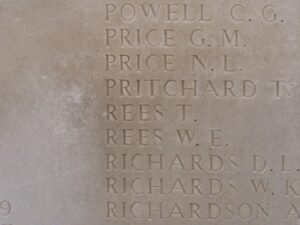
Abel Thomas, Private, 191884, Royal Welsh Fusiliers. Abel was the son of John and Mary Thomas, of 7, Tynewydd Cottage. He had initially enlisted into the 9th Battalion, Royal Welsh Fusiliers, and had served in France with the battalion, which was attached to 58 Brigade, 19th Division, from 19 July 1915. At some time Abel was invalided home and attached to the 421st Agricultural Company, Labour Corps. He died in Carmarthen Hospital on 2 April 1918, aged 23, and is buried in Carmel Baptist Chapelyard and Extension. Abel does not appear to be commemorated locally.
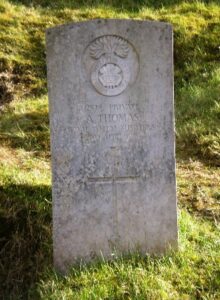
David Clement Thomas, Sapper, 66100, Royal Engineers. David was born at Golden Grove, the son of Ebenezer and Hannah Thomas. The family later resided at 77, Dillwyn Street, Llanelli. He worked there as a Sorting Clerk and Telegraphist. David had served in the Middle East with the Welsh Field Company, Royal Engineers, and remained in the Royal Engineers for several months after the armistice, being was posted to ‘L’ Signal Battalion, Royal Engineers. He was demobilised in the summer of 1919, and was on holiday in Pembrokeshire when he was killed in a cycling accident at Letterston on 13 September 1919. David was 32 years old, and is buried at Llanelli (Box) Cemetery, in the old section. He is not commemorated at Golden Grove.
David Williams, Sapper, 223814, Royal Engineers. David was the son of John and Hannah Williams, of Cwmgelynew, Golden Grove. He worked as a stonemason prior to enlisting into the Royal Engineers on 10 January 1917. David served with the 2/1st Highland Field Company, Royal Engineers, but was soon to become ill and was discharged from the army as medically unfit on 16 April 1917 after having been diagnosed as suffering from tuberculosis. He died of tuberculosis at Golden Grove on 29 September 1919, aged 44. He is not commemorated by the CWGC, and there is no evidence to link his illness or death to his short time in the colours.
John Williams, Private, 74846, Royal Welsh Fusiliers. John was the son of John and Hannah Williams, of Cwmgelynew, Golden Grove and was the husband of Lily Beatrice Williams, of 7, Commercial Street, Pontnewydd. He had served with the Military Foot Police before being transferred into the 9th Battalion, Royal Welsh Fusiliers late in 1917. The battalion was in France attached to 58 Brigade, 19th (Western) Division. The Division had fought gallantly at Loos, the Somme and at Third Ypres. In 1918 they were caught up in the German Spring Offensive near St. Quentin, where they suffered terrible casualties, during the Battle of Bapaume, where they were driven back by a stronger German force. The decimated division moved to Ypres to rebuild, but were caught up in the German attack at Messines in April. John must have been wounded here, and was sent home for treatment. He died of wounds, aged 39, on 23 May 1918, and is buried at Pontnewydd (Holy Trinity) Churchyard. John is not commemorated at Golden Grove.
John Henry Williams, Private, M/287507, Royal Army Service Corps. John was the son of John and Sarah Williams, of Tynewydd, Carmel. He enlisted into the Army Service Corps on 5 February 1917 as a Driver, and was posted to Grove Park, Middlesex. John had only been in the army for five weeks when he took ill, and died of pneumonia at the Military Hospital at Hounslow, Middlesex on 9 March 1917, aged 24. He was brought home and buried with full military honours in Carmel Baptist Chapelyard & Extension. His younger brother Idwal was taken prisoner by the Germans in April 1918, but survived the war. He is not commemorated at Golden Grove.

World War Two, 1939-1945
John Ronald Campbell, Major, 33632, Coldstream Guards. John was the son of Brigadier General John Vaughan Campbell, VC, CMG, DSO, and of Amy Dorothy Campbell. His father was the son of the 2nd Earl Cawdor, of Stackpole and Golden Grove. John was the husband of Ethel Mildred Campbell, of Hadnall, Shropshire. John served as a regular Officer with the Coldstream Guards, following the family tradition, as it was the Regiment that his father won the Victoria Cross with during the Great War. (See Carmarthenshire Heroes page). After the German invasion of Poland, the British Government sent an expeditionary force to France, and with it was the 1st Battalion, Coldstream Guards. John was a Major with the battalion, In May 1940 the Germans invaded France and Belgium, and within days John was dead. He had been killed in action on 30 May 1940 during some hard fighting, and is buried at Veurne Communal Cemetery Extension, Belgium. John was 35 years old.
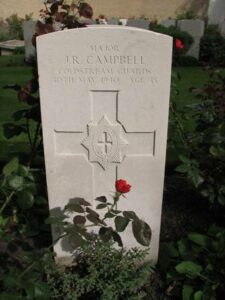
William John Goodfellow, Sergeant (Observer), 653294, Royal Air Force. William was the son of William Thomas Goodfellow and Elizabeth Goodfellow, of Penygroes. He served as an Observer with 150 Squadron, Royal Air Force, which was based at RAF Kirmington, equipped with the Vickers Wellington III. On 28 October 1942 William took off from Kirmington aboard Wellington BK310, which had been despatched to carry out a mine-laying operation, which was known in the RAF as ‘Gardening’. The Wellington crashed into high ground in the Quantocks, Somerset, on the return journey the following morning of 29 October, injuring three crew-members and killing William. He was 31 years old and is buried in Carmel Baptist Chapelyard and Extension.
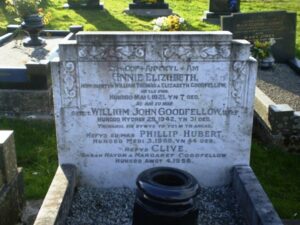
Bertie Lewis, Private, 10699128, Royal Army Ordnance Corps. Bertie was the son of John Thomas Lewis and Jemima Lewis, of Iron Gate, Golden Grove, Carmarthenshire. He had become an accountant before joining the Royal Army Ordnance Corps at the outbreak of war, and was posted to North Africa. Bertie sadly died in Algeria while on active service, the official cause of death was sleeping sickness. Bertie was buried at El Alia Cemetery, Algeria. He was 37 years old.
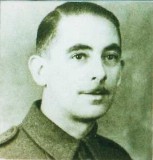
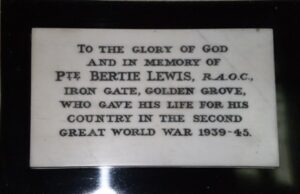
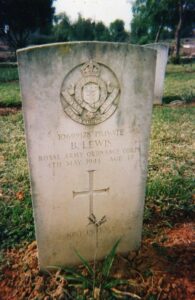
Thomas Randall Lewis, Private, 14208080, The Buffs (Royal East Kent Regiment). Thomas was the son of Rees and Elizabeth Lewis, of Carmel. He served with the 5th Battalion, The Buffs (Royal East Kent Regiment). The battalion saw service in France 1940 with 36th Infantry Brigade, 12th (Eastern) Division, and was evacuated from Dunkirk. During 1942 the 36th Brigade was attached to the 78th Division and took part in Operation Torch, the Allied landings in North Africa. The division then fought in North Africa with the 1st Army. Thomas was killed during the final stages of the Tunisian campaign on 24 April 1943. He was 22 years old and is buried in Medjez-El-Bab War Cemetery, Tunisia.
Thomas Ivor Morris, Driver, T/50693, Royal Army Service Corps. Thomas of Thomas and Anna Morris of Carmel, and the husband of Mary Morris, of Hafod, Swansea. He served with the 2nd Ammunition Column, Royal Army Service Corps. Thomas was probably in France with the BEF in 1939. He died at Aldershot on 15 January 1940, aged 33, and is buried in Carmel Baptist Chapelyard and Extension. The photograph below is courtesy of Bev Lewis.
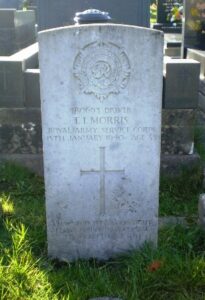
David Owen Perkins, Petty Officer Stoker, D/KX 81082, Royal Navy. David was the son of Richard and Sarah Perkins, of Ffynon, Maesybont. He served with the Royal Navy aboard the Leander Class light cruiser H.M.S. Neptune. On 19 December 1941 Neptune was on patrol in the Mediterranean as part of Force K, when she sailed into an Italian minefield which disabled her propellers. Following an unsuccessful attempt to tow her out of the minefield, which led to the sinking of another destroyer, Neptune struck more mines and sank with the loss of all but 30 of her crew. David was 32 years old when he died that day and is commemorated on the Plymouth Naval Memorial, Devon. His parents are buried in Hebron Chapel, Maesybont.